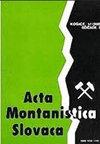The potential of Sudanese Refractory Gold Ores Characterization and Pre-treatment in Ariab Mines (VMS) in Red Sea (Sudan)
IF 1.4
4区 地球科学
Q2 GEOSCIENCES, MULTIDISCIPLINARY
引用次数: 0
Abstract
This laboratory work demonstrates the ability to characterize and pre-treat Sudanese refractory gold ores at Ariab mines to extract the gold with optimal parameters. Characterization studies were performed by AAS, XRF and XRD analysis to assess the abundance of elements and mineral phases. In addition, the acidity of the ore was examined to estimate the effective amount of lime. The ore was subjected directly to cyanidation without any pre-treatment. High oxidation reagent processes were carried out to pre-treat the ore. Chemical analysis results show the gold grade to be 1.37 g/t. In addition, the ore contained 51.78% Fe2O3, 43.40% SO3, 2.39% CuO, 1.47% SiO2, 0.35% Cr2O3, 0.17% CaO, 0.08% As2O3, 0.06% ZnO and 0.06% MnO. The XRD result shows that the ore phases are Pyrite (FeS2), Chatkaite (Cu6Fe+2Sn2S2) and Quartz (SiO2). The investigations of direct cyanidation elucidated that the ore can consume a high amount of cyanide with unsatisfactory recoveries for gold (Exgold ≤39.41%). The influence of the cyanide concentration, pulp density (% by weight), leaching time hr, agitator speed and pH were examined in direct cyanidation experiments. In pre-treatment experiments, the effect of hydrogen peroxide (H2O2) and concentrations on gold recovery was studied. The pre-treatment of the ore with H2O2 achieved a good impact on the gold extraction performance. The higher gold extraction was obtained at hydrogen peroxide (H2O2) 300 ppm, cyanide concentration 3500 ppm, leaching time 10 hr, pH=10.5 and pulp density 40%.苏丹难处理金矿在红海(苏丹)阿拉伯矿(VMS)中的表征及预处理潜力
这项实验室工作证明了在阿拉伯矿山对苏丹难处理金矿进行表征和预处理的能力,以便以最佳参数提取黄金。通过原子吸收光谱(AAS)、XRF和XRD分析对其进行了表征,以评估元素和矿物相的丰度。此外,还检测了矿石的酸度,以估计石灰的有效量。该矿石未经任何预处理直接进行氰化处理。采用高氧化剂工艺对矿石进行预处理,化学分析结果表明,金品位为1.37 g/t。矿石中Fe2O3含量为51.78%、SO3含量为43.40%、CuO含量为2.39%、SiO2含量为1.47%、Cr2O3含量为0.35%、CaO含量为0.17%、As2O3含量为0.08%、ZnO含量为0.06%、MnO含量为0.06%。XRD结果表明,矿石相为黄铁矿(FeS2)、Chatkaite (Cu6Fe+2Sn2S2)和石英(SiO2)。直接氰化试验结果表明,该矿石氰化物消耗量大,金回收率不理想(Exgold≤39.41%)。在直接氰化试验中考察了氰化物浓度、矿浆密度(重量%)、浸出时间、搅拌转速和pH对氰化效果的影响。在预处理实验中,研究了过氧化氢(H2O2)和浓度对金回收率的影响。用H2O2对矿石进行预处理,对提金效果有较好的影响。在过氧化氢(H2O2)浓度为300 ppm、氰化物浓度为3500 ppm、浸出时间为10 hr、pH=10.5、矿浆密度为40%的条件下,金的提取率较高。
本文章由计算机程序翻译,如有差异,请以英文原文为准。
求助全文
约1分钟内获得全文
求助全文
来源期刊

Acta Montanistica Slovaca
地学-地球科学综合
CiteScore
3.60
自引率
12.50%
发文量
60
审稿时长
30 weeks
期刊介绍:
Acta Montanistica Slovaca publishes high quality articles on basic and applied research in the following fields:
geology and geological survey;
mining;
Earth resources;
underground engineering and geotechnics;
mining mechanization, mining transport, deep hole drilling;
ecotechnology and mineralurgy;
process control, automation and applied informatics in raw materials extraction, utilization and processing;
other similar fields.
Acta Montanistica Slovaca is the only scientific journal of this kind in Central, Eastern and South Eastern Europe.
The submitted manuscripts should contribute significantly to the international literature, even if the focus can be regional. Manuscripts should cite the extant and relevant international literature, should clearly state what the wider contribution is (e.g. a novel discovery, application of a new technique or methodology, application of an existing methodology to a new problem), and should discuss the importance of the work in the international context.
 求助内容:
求助内容: 应助结果提醒方式:
应助结果提醒方式:


